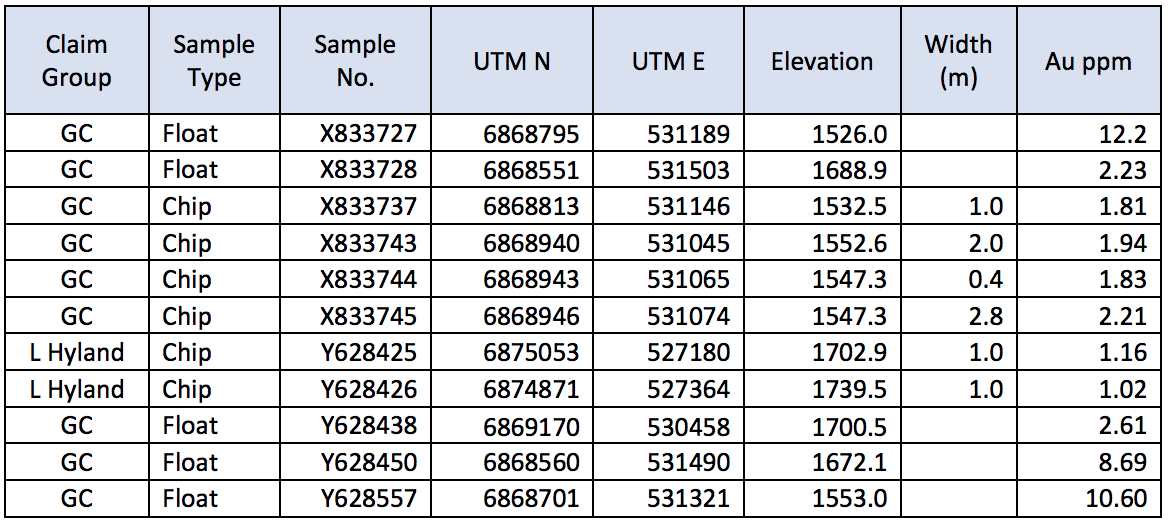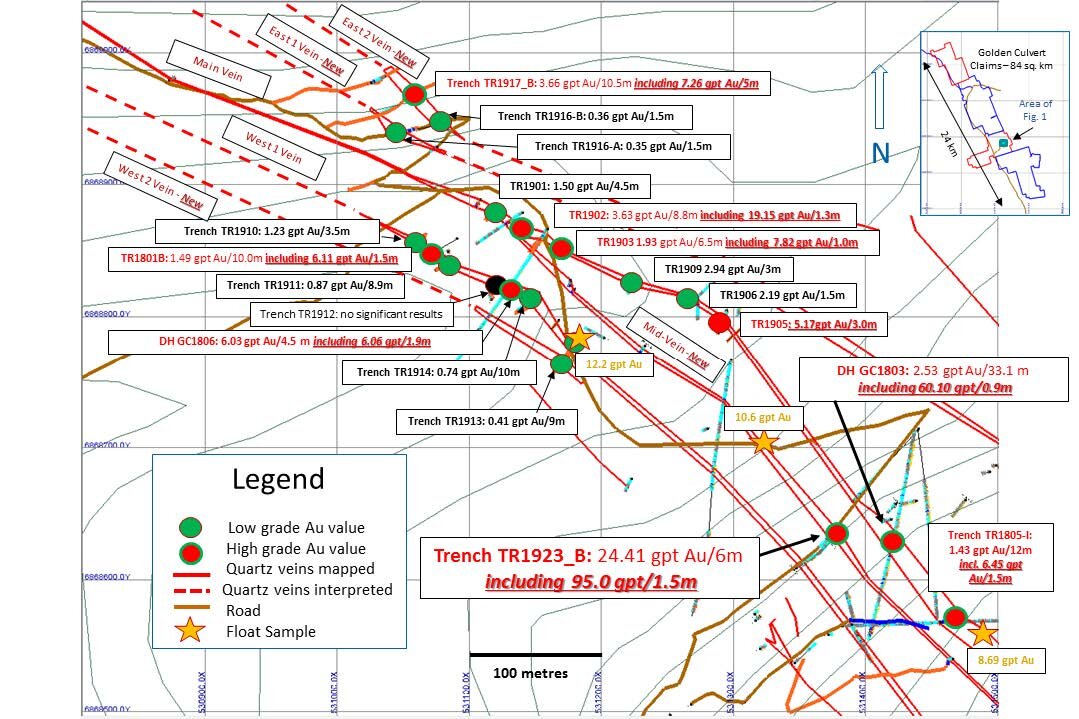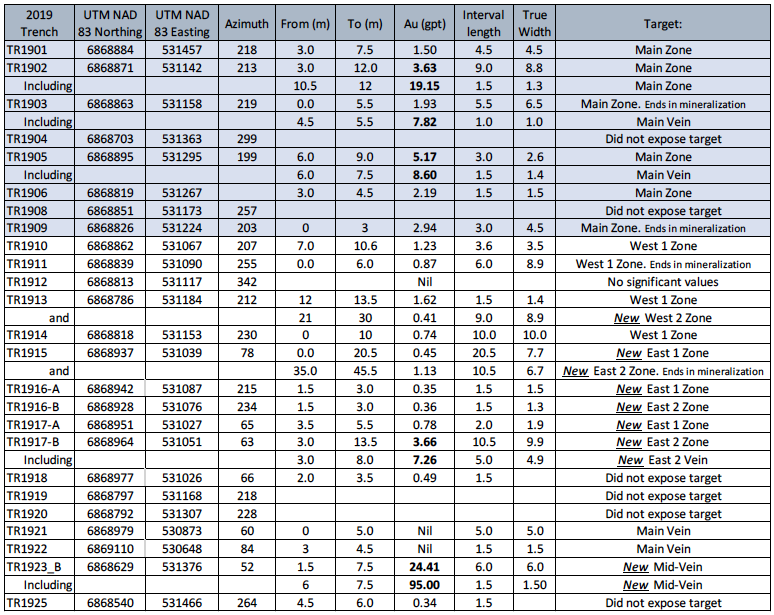October 23, 2019 – Toronto, Ontario: Stratabound Minerals Corp. (TSXV: SB) (“Stratabound” or “the Company”) is pleased to announce the final results from its recently completed 2019 gold exploration trenching program on the Golden Culvert Project located in the Hyland-Selwyn gold belt in the eastern Yukon Territory. The most significant highlight came from trench TR1923-B which yielded 24.41 gpt Au over 6.0m including the highest gold assay ever received to date of 95.0 gpt Au over 1.5m. The trench was designed as an extension of an open-ended interval of 2.33 gpt Au/3.0m including 5.32 gpt Au/1m in trench TR1804-H completed in 2018. Both trench intersections are now re-interpreted to be a new vein, the “Mid-Vein” that occurs between the previously known Main and West 1 Veins.
Additionally, three other new parallel gold bearing quartz vein structures were discovered, the highlight of which returned 12.30 gpt Au/1.0m within 7.26 gpt Au/5.0m in trench TR1917-B.
This press release relates to a second phase of wider spaced trenches designed to explore the quartz vein and breccia structures controlling gold mineralization further beyond the 0.5 km of strike concentrated on around the Main Discovery Vein to date. The previous press release of October 7, 2019 related to six close-spaced 2019 trenches encountering significant gold mineralization in all six trenches highlighted by trench TR1902 yielding 19.15 gpt Au/1.5m within a larger envelope yielding 3.63 gpt Au/9.0 metres. As well, more higher-grade intervals were exposed within moderate grade envelopes including 7.82 gpt Au/1.0m in TR1903 and 8.60 gpt Au/1.5m in TR1905 focused around the Main Discovery Vein outcrop that has historic chip sample results up to 22.8 gpt Au over 1.0m.
Main Zone Strike Length Extended
This latest phase of the program has extended and exposed the Main Discovery Vein structure with trenches, outcrop and subcrop to demonstrate that the structure remains open beyond the 1.9 kilometres of strike explored to date. Bedrock exposure in the northern 1.4km was hampered by deep overburden such that significant gold mineralization, on the surface at least, appears to be concentrated along the southern 570 metres where it remains open beyond and within the 3 km +20ppb gold soil anomaly surrounding the mineralized veins. The current interpretation is that, though the vein structures themselves are continuous over kilometres, the gold may well be confined to “shoots” within the vein structures, perhaps where unidentified cross structures, geological or geochemical boundaries allow for gold mineralization to occur. Other “blind” shoots may well occur elsewhere within the vein corridor continuum at depth and along strike. Results are detailed in Figure 2 below.
New Gold Vein Discovery 7.1 Kilometres along Strike
In the final days of the campaign a new outcropping, gold-bearing vein was discovered during helicopter supported reconnaissance approximately 7.1 kilometres north along the general strike of the Main Discovery zone and open-ended +20ppb gold in soil anomaly. The vein was exposed in outcrop over 15.8 metres of strike averaging 0.46 gpt Au/2.0m at its widest and as high as 1.02 gpt Au/1.0m. The exposure was not trenched to determine the full width of mineralization. The new vein averaged a strike of 326° with a vertical dip similar to veins found 7. 1 km to the south on the Main Discovery Zone. The vein occurs at the eastern edge of an historic open-ended 50 ppb gold in soil anomaly. A second quartz breccia grab sample from a small outcrop 260m to the northwest interpreted to be the same vein yielded 1.16 gpt Au. Both occurrences are within highly altered phyllite host rocks with associated sulphide mineralization similar to the Main Discovery Zone. No exploration of any kind has ever been done in the intervening 7.1 kilometres between this new discovery and the Main Discovery Zone before this season. The area remains open to explore along strike in both directions.

New Main Zone Discoveries
Of further significance, four more parallel gold mineralized veins have been discovered in addition to the two previously identified in 2018, effectively widening the gold vein “corridor” from 50 metres to 130 metres wide providing a broader target area for future exploration and diamond drilling. Multiple other parallel quartz vein and breccia structures have been identified outlying the main 130 metre wide goldbearing vein “corridor” that, though not well explored, have not yielded significant gold values to date. More gold bearing “shoots” within these other veins remain to be explored. The quartz vein structures continue to demonstrate a near vertical attitude. Highlights of the new vein discoveries include 7.26 gpt Au/5.0m within 3.66 gpt Au/10.5m in trench TR1917-B on the new East 2 Vein and trench TR1923-B yielding 24.41 gpt Au over 6.0m including the highest gold assay received to date of 95.0 gpt Au over 1.5m on the new Mid-Vein. Trench TR1923-B was designed as an extension of an open-ended interval of 2.33 gpt Au/3.0m including 5.32 gpt Au/1m in trench TR1804-H completed in 2018. (Figure 2)
West 1 Vein In-fill trenches
In-fill trench results along the West 1 Vein revealed only narrow, low grade gold values with the best result being 0.74 gpt Au/10.0m. Despite these weaker surface results, drilling the West 1 vein in 2018 yielded 6.02 gpt Au/4.5m including 12.98 Au/2.0m with visible gold in GC1806 at 50m below surface and 1.76 gpt Au/7.6m including 6.06 Au/1.9m in GC1802 at 110 metres below the 2019 surface trenches.
Float and Chip Sampling Results
Sampling of quartz float trains are an excellent prospecting practice in this region of North America as it has not seen any continental glaciation leaving overlying eroded rock detritus fairly close to the original bedrock source in “trains” that lay upon the strike of the underlying gold structures. Best results of the sampling program include 12.20 gpt Au from quartz float a few metres beyond the east limit of trench TR1913; 10.60 gpt Au from quartz float on strike of the Mid-Vein, and 8.69 gpt Au on strike of the Main Vein. (Table 1, Figure 2)

President and CEO, R. Kim Tyler commented, “These are still early days for the Golden Culvert project, being only our second year of exploration, and we are again pleased to receive more high-grade gold values within lower grade haloes comparable to those achieved at Golden Predator Mining’s 3 Aces Project and Aben Resources’ Justin Project located within 30 kilometres of Golden Culvert. Building upon last year’s work we have further demonstrated that significant gold mineralization occurs across at least 570 metres of strike length within host structures that extend at least 1.9 kilometres or more and that it is plausible that more gold mineralization may occur in shoots along this and other structures. Further, we have made new gold vein discoveries that have widened our corridor of gold-bearing structures and extended the exploration potential to at least 7.1 kilometres enhancing our chances of more significant gold to be discovered across, as well as along strike and to depth.”

Trench results and particulars related to this and the previous press release are detailed in Table 2 below.

Summary grades are reported uncapped as there are insufficient results returned to date to make a reasonable capping determination.
Analytical, QA/QC Methods and Protocol:
All trench samples were secured in plastic bags sealed with cable wrap ties and placed into plastic rice bags similarly sealed and delivered to the ALS Global preparation facility in Whitehorse, Yukon Territory where they were crushed until better than 70% passed a 2mm sieve. A 250g split was pulverized until better than 85% passed a 75-micron screen. Gold was tested by a 30-gram fire assay method with an atomic absorption finish at the Vancouver ALS lab facility. Assay results that exceed 100 gpt Au by this method are re-assayed by metallic screening followed by fire assay with a gravimetric finish. In addition to the quality assurance and quality control program performed by ALS, Stratabound personnel insert internationally certified standards and blanks into the sample stream at the rate of one QA/QC sample for every 15 samples and maintain a program of duplicate sampling on pulp rejects.
About the Golden Culvert and Little Hyland Properties
Golden Culvert and Little Hyland cover 83.8 square kilometres in the southeast Yukon Territory across a 24-kilometre strike located approximately 20 kilometres northeast of and parallel to Golden Predator Mining Corp.’s 3 Aces property and 30 km north along strike of Aben Resources’ Justin Project. Past work has outlined a northerly trending, 3 kilometre by 250 metre, +30 ppb Au up to 791 ppb Au gold-in-soil anomaly that remains open at both ends. During 2018 samples were taken and assayed from six trenches and eight drill holes (1,355 metres of diamond drilling). Significant results from 2018 drilling include 60.1 gpt Au over 0.9m within 2.53 gpt Au over 33.1 metres.
About Stratabound
Stratabound Minerals Corp. is a Canadian exploration and development company focused on gold exploration in the Yukon Territory. The Company also holds a significant land position that hosts three base metals deposits in the Bathurst base metals camp of New Brunswick featuring the Captain Copper-Cobalt Deposit that hosts an NI 43-101 compliant Measured+Indicated resource.
Stratabound management has a diversified track record of exploration, development and operating successes that will facilitate the development of the Company’s exploration projects.
Mr. R. Kim Tyler, P.Geo., President and CEO of Stratabound, and a “Qualified Person” for the purpose of NI 43-101, was responsible for managing and supervising the exploration program and has verified the data disclosed, including sampling, analytical, and test data underlying the information or opinions contained in this disclosure. Mr. Tyler has reviewed and approved the contents of this news release.
For further information, please see the Golden Culvert presentation and the NI 43-101 technical report on the Stratabound web site, www.stratabound.com.
For further information contact:
R. Kim Tyler, President and CEO
705-822-9771
ktyler@stratabound.com
www.stratabound.com
Neither the TSX Venture Exchange nor its Regulation Services Provider (as that term is defined in the policies of the TSX Venture Exchange) accepts responsibility for the adequacy or accuracy of this release.
WARNING: The Company relies upon litigation protection for “forward looking” statements. The information in this release may contain forward-looking information under applicable securities laws. This forward-looking information is subject to known and unknown risks, uncertainties and other factors that may cause actual results to differ materially from those implied by the forward-looking information. Factors that may cause actual results to vary materially include, but are not limited to, inaccurate assumptions concerning the exploration for and development of mineral deposits, currency fluctuations, unanticipated operational or technical difficulties, changes in laws or regulations, failure to obtain regulatory, exchange or shareholder approval, risks of obtaining necessary licenses and permits, changes in general economic conditions or conditions in the financial markets and inability to raise financing. Readers are cautioned not to place undue reliance on this forward-looking information. The Company does not assume the obligation to revise or update this forward-looking information after the date of this release or to revise such information to reflect the occurrence of future unanticipated events, except as may be required under applicable securities laws.
